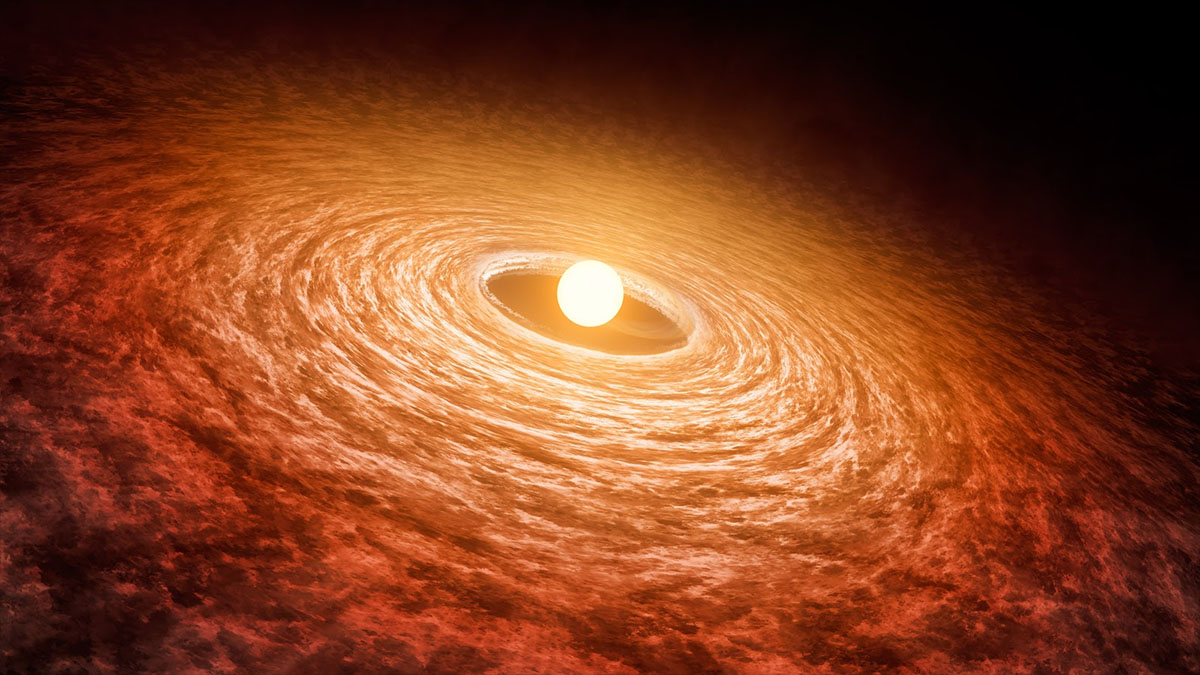a baby star and a cloud of organic molecules may help us in the search for aliens

Young solar systems still trying to form out of a disk of gas and dust are fascinating places that can hold answers to many mysteries about our own origins. Take the protoplanetary disk around V883 Ori, which is undergoing a heating event as a side-effect from the young star’s gluttony. V833 Ori is an FU Orionis star, so it’s growing larger by stealing matter from the protoplanetary disk, and as a result, getting more massive and hotter. This powerful flare-up is heating the ice in the disk, releasing gases we can analyze, and it’s those gases that are the important part of the story because a team of astronomers found that it contained a medley of organic molecules like acetone and methyl formate, precursors to the chemistry we associate with life.
Not only are there organic molecules, but they’re spread in a band almost 5.6 billion miles wide, which is nothing to take lightly. By comparison, Pluto’s orbit places it 3.67 billion miles from the sun, so the disk around V833 Ori is full of potential building blocks for alien microorganisms. As baby planets start clearing out and absorbing this gas and dust, the heat of their formation and the chemical reactions enabled by their cooling, coupled with more organic molecules and ice from comet and asteroid impacts, could stir those chemicals just enough for primitive life to take hold, much the same way we think it happened on Earth roughly 3.5 billion years ago.
What this detection, combined with other traces of organic chemicals found throughout the cosmos, is that it’s not exactly unfounded to think that life has a chance everywhere there’s even a hint of favorable chemistry. If clouds of organic building blocks are floating in space, raining down from the sky on young worlds, and wherever we look we seem to find something hanging on to some sort of existence, it makes sense that across the trillions of trillions of worlds, life had plenty of chances to arise. The universe seems to be doing the equivalent of tossing all the raw ingredients for living things into trillions of possible pots and stirring them for hundreds of millions of years. The math says that millions, if not billions of these experiments had to have been successful for our existence to make scientific sense.
Of course, we won’t know what happens around V883 Ori because even if everything goes absolutely perfectly, it would take another few billion years for the first living things to emerge, and another three to five billion years for complex animals and civilizations to evolve. By that point, Earth would be an uninhabitable rock scorched by a red giant sun. It would be an even greater time disparity than the one between us and Kepler-452b, and one we’d be easily prone to given the vastness of space and the quadrillion years still left in the universe’s star forming phase, before everything goes dark and cold, sending whatever species will still exist in search of new homes. But the important part is that we at least know that such aliens have a good chance at evolving in the first place, and V833 Ori is an important part of that.
See: Lee, E-J., et. al., The ice composition in the disk around V883 Ori revealed by its stellar outburst, Nature Astronomy (2019) DOI: 10.1038/s41550-018-0680-0





